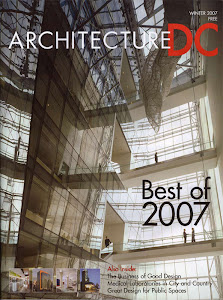Today's Washington Post features an article on rooftop additions to rowhouses in the District. And while there are no doubt some horrible examples of rooftop additions in DC, such as the one pictured in the article, the reactions to these ill-conceived modifications can be just as concerning. Take for example a developer mentioned in the piece, who states that "A year from now...a visitor to the street won't know if the building was constructed 'in 2007 or 1907.'" Or the statement of DC Office of Planning assistant director Travis Parker, who the Post quoted as saying that an approach to dealing with such additions is to draft regulations "that define its existing building types and set that as the existing standard." The concern raised by such statements is that they indicate the extreme, yet often too-quickly embraced notion that either such additions and alterations to an existing building should either strictly adhere to a defined style or be prohibited all together. But there are certain inherit risks to this approach.
As a professional in the design industry and a student of the city, there is a certain disdain that I feel towards this approach. I believe that a building should be of the time. That a building, like a city, is dynamic...it ages, and it changes over time. This can be a beautiful aspect of any renovation, for it provides the opportunity to create a dialogue through the design, between the existing and the new which it must respond to, that serves several ends. First, such a dialogue informs the observer of the life of a building. One understands the development that the building went through. And such a dialogue can take many different approaches, from the respectful melding of similar masses or materials, to the more aggressive interplay of old and new. But this dialogue further serves to distinguish the existing, original contributing elements of a building from that which is added, serving to add authenticity to that which is original, and simultaneously add an element of contemporaneousness to the composition.
Granted, this must be done well. Such an addition should be respectful in many ways to the existing context. The forms, scale, massing, and materials of the existing structure and its surroundings should inform the design of the renovation, modification, or addition. It is a question of the language, the underlying characteristics of the object, rather than the motif. But all too often when we hear discussions such as this, regarding additions to structures that we are compelled to label 'historic' or 'contributing', the tendency is to respond 'in kind' through the employment of the motifs of a style. I feel that this is detrimental, as motifs have, and continue to be, employed in ways that are not appropriate or original. Take for instance one of the examples featured in the article. The composition includes a large mansard roof with two tall windows, over an existing three window arrangement on the second floor existing facade. While the composition employs elements of a design style, they are applied haphazardly. Furthermore the scale of the addition overpowers the existing. While it is clear to see that this is an example of what not to do, it is a consequence that such a mentality of working within a prescribed architectural style can produce.
While zoning regulations and the designation of areas as historic districts are an important means of moderating the density and appropriateness of a design in our cities' neighborhoods, it is important that they not be used in a way that would stymie the advancement of modern design. There are countless, worthy examples of good, modern design in historic districts, and the results can often render vibrant, energetic neighborhoods. Therefore, the regulations should be based on massing and scale, more so than actual stylistic elements. If our existing historical buildings are to remain truly unique and authentic, then we should not degrade them with newly built impostors. We respect our past by responding and engaging appropriately, not by mocking.
Tuesday, September 25, 2007
In The News: 'Look What Just Popped Up'
Subscribe to:
Post Comments (Atom)









No comments:
Post a Comment